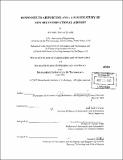| dc.contributor.advisor | John-Paul B. Clarke. | en_US |
| dc.contributor.author | Evans, Antony David, 1977- | en_US |
| dc.contributor.other | Massachusetts Institute of Technology. Dept. of Aeronautics and Astronautics. | en_US |
| dc.coverage.spatial | n-us-nj | en_US |
| dc.date.accessioned | 2005-09-26T19:23:19Z | |
| dc.date.available | 2005-09-26T19:23:19Z | |
| dc.date.copyright | 2002 | en_US |
| dc.date.issued | 2002 | en_US |
| dc.identifier.uri | http://hdl.handle.net/1721.1/28254 | |
| dc.description | Thesis (S.M.)--Massachusetts Institute of Technology, Dept. of Aeronautics and Astronautics; and, (S.M.)--Massachusetts Institute of Technology, Engineering Systems Division, Technology and Policy Program, 2002. | en_US |
| dc.description | Includes bibliographical references (p. 119-121). | en_US |
| dc.description.abstract | Airport delays are a significant problem in the United States air transportation system. Between 1997 and 2000 the number of flights delayed increased by between 20 and 25% per year, despite only a 3 to 5% increase in enplanements per year. Newark International Airport (EWR), one of New York City's primary airports, is one of the airports in the United States most impacted by delays. Newark had the highest percentage of operations delayed in 1999, and was second only to LaGuardia Airport in 2000. Nearly 85% of delays at Newark are caused by adverse weather impacting the airport. Because of limited capacity and a very full schedule operated at the airport, when adverse weather impacts the airport departure operations are severely delayed. Despite this, unlike the national average, delays at Newark have not increased significantly since 1998. This indicates that the airlines, air traffic control (ATC), and the Port Authority of New York and New Jersey have successfully adapted. On June 29, 2000, a research team from MIT visited Newark Airport to identify the key problems and assess the effectiveness of any adaptations made. Results of this study indicate that airspace capacity limitations downstream of the airport become a primary flow constraint at the airport, and that when these constraints occur they are the source of most surface delays. Responses to the delays at Newark have been both tactical and strategic. Key tactical ATC responses examined include the application of restrictions; re-routing with the help of the National Playbook; the use of decision-aiding tools; improved inter-facility communication; and utilization of runway 11-29. Key strategic ATC responses examined include the formation of the Air Traffic Control System Command Center, and the New York airspace redesign. A number of tactical airline responses to delays were also examined, including cancellation of low priority flights and the transfer of the passengers to ground transportation; pre-sequencing of departures; and improved access to information. Key strategic responses examined include changes to the schedule operated at the airport, and particularly flattening out of the banks operated; a new fleet, which requires less maintenance and has greater dispatch reliability; and improved relations with the FAA and Port Authority of New York and New Jersey. After examination of the problems at the 10 most delayed airports in the United States, the applicability of the key responses identified at Newark to these airports was also examined in detail. Those airports for which the most responses were identified to be applicable were Atlanta, San Francisco, Philadelphia and Dallas/Fort Worth. Those responses identified to be most applicable to other airports were the further extension of the National Playbook to other regions, the use of decision aiding tools, airspace redesign, pre-sequencing of departures, and a decrease in the number of operations at the airport. A policy analysis was completed for each of these responses. | en_US |
| dc.description.statementofresponsibility | by Antony David Evans. | en_US |
| dc.format.extent | 121 p. | en_US |
| dc.format.extent | 9423983 bytes | |
| dc.format.extent | 9439204 bytes | |
| dc.format.mimetype | application/pdf | |
| dc.format.mimetype | application/pdf | |
| dc.language.iso | en_US | |
| dc.publisher | Massachusetts Institute of Technology | en_US |
| dc.rights | M.I.T. theses are protected by copyright. They may be viewed from this source for any purpose, but reproduction or distribution in any format is prohibited without written permission. See provided URL for inquiries about permission. | en_US |
| dc.rights.uri | http://dspace.mit.edu/handle/1721.1/7582 | |
| dc.subject | Technology and Policy Program. | en_US |
| dc.subject | Aeronautics and Astronautics. | en_US |
| dc.title | Responses to airport delays : a system study of Newark International Airport | en_US |
| dc.type | Thesis | en_US |
| dc.description.degree | S.M. | en_US |
| dc.contributor.department | Massachusetts Institute of Technology. Department of Aeronautics and Astronautics | |
| dc.contributor.department | Massachusetts Institute of Technology. Engineering Systems Division | |
| dc.contributor.department | Technology and Policy Program | |
| dc.identifier.oclc | 51688725 | en_US |
